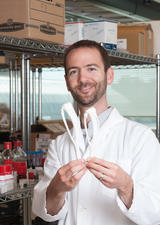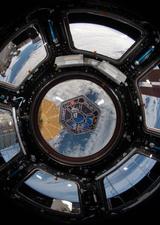
Understanding bones and joints
Before bone and joint conditions can be prevented, diagnosed or treated, researchers need to understand how bones and cartilage form and grow on a cellular and genetic level and what the underlying causes of disease and inflammation are. This kind of basic knowledge lays the foundation for clinical or patient-based research.

The long and short of bone development
How did you get so tall? People of tall stature have been asked this throughout their lives. Oftentimes the answer is obvious – “oh, my parents are really tall.” But how come one person’s bones grow longer and faster than another’s?
“Sure, our genes are largely responsible for our stature,” says evolutionary biologist Campbell Rolian, a researcher in the McCaig Institute who studies skeletal variation in size and shape between individuals. “But we still don’t have a complete grasp of how genetic variation is translated into height variation – you versus me – at a cellular and developmental level,” he says.

Understanding the biomechanics of the joint
“I was always intrigued as to why and how things worked – from a very early age,” says McCaig Institute researcher Nigel Shrive. His curiosity, along with some sage advice from a teacher, led him to a degree in biomedical engineering, where he became interested in how joints function and what cases them to deteriorate in osteoarthritis (OA).
Shrive and his team study the mechanical and biological interactions that occur in joint or tissue after injury. These interactions affect the way loads get transmitted from one bone to another across a joint. Once researchers understand what causes the progression of OA, new ways to test for and treat the disease can be developed.
Can Rudolph help researchers understand cartilage regeneration?
Reindeer antlers are made of cartilage and bone and are covered with soft, furry skin called velvet. At the height of summer, male antlers grow an astonishing 1.5 – 2.5 centimeters a day – faster than any other developing mammalian bone. In the winter, the antlers fall off, only to regrow again in the spring in much the same pattern. Dr. John Matyas, McCaig Institute member and professor in the Faculty of Veterinary Medicine at the University of Calgary wants to understand the causes behind this amazing growth. “Antlers are the only mammalian organ that completely regenerates, year after year,” says Matyas. “If we could understand how antler bone and cartilage grows and regenerates so quickly, we may be able to apply that knowledge to human bone.”
He believes it all has to do with stem cells.

Astronomical bone loss recorded from space travel
Escaping the Earth’s orbit and floating through space for a six-month mission results in an average bone loss equating to nearly two decades of bone loss on earth. That means a 40-year old astronaut returns to Earth with a 60-year old skeleton.
Findings from the TBone study reveal that bone loss progresses with the length of a space mission despite daily exercise programs designed to prevent bone loss

